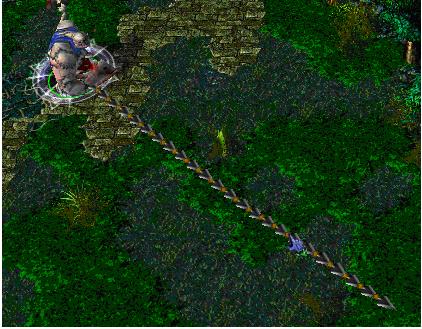hdu1698(线段树,简单的成段更新)
来源:互联网 发布:azw3电脑打开软件 编辑:程序博客网 时间:2024/06/07 05:05
地址:http://acm.hdu.edu.cn/showproblem.php?pid=1698
Just a Hook
Time Limit: 4000/2000 MS (Java/Others) Memory Limit: 32768/32768 K (Java/Others)Total Submission(s): 12488 Accepted Submission(s): 6221

Now Pudge wants to do some operations on the hook.
Let us number the consecutive metallic sticks of the hook from 1 to N. For each operation, Pudge can change the consecutive metallic sticks, numbered from X to Y, into cupreous sticks, silver sticks or golden sticks.
The total value of the hook is calculated as the sum of values of N metallic sticks. More precisely, the value for each kind of stick is calculated as follows:
For each cupreous stick, the value is 1.
For each silver stick, the value is 2.
For each golden stick, the value is 3.
Pudge wants to know the total value of the hook after performing the operations.
You may consider the original hook is made up of cupreous sticks.
For each case, the first line contains an integer N, 1<=N<=100,000, which is the number of the sticks of Pudge’s meat hook and the second line contains an integer Q, 0<=Q<=100,000, which is the number of the operations.
Next Q lines, each line contains three integers X, Y, 1<=X<=Y<=N, Z, 1<=Z<=3, which defines an operation: change the sticks numbered from X to Y into the metal kind Z, where Z=1 represents the cupreous kind, Z=2 represents the silver kind and Z=3 represents the golden kind.
11021 5 25 9 3
Case 1: The total value of the hook is 24.
#include<cstdio>#include<cstring>#include<iostream>using namespace std;#define M 100010struct node{int l,r,sum;}tree[3*M];void ori_tree(int i,int l,int r){int m=(l+r)/2;tree[i].sum=1; //这里赋的值既是hook的材料,也是一个标记,当sum的值大于0时,这一段hook全由一种材料组成 tree[i].l=l;tree[i].r=r;if(l!=r){ori_tree(i*2,l,m);ori_tree(i*2+1,m+1,r);}}void updata(int i,int l,int r,int num){if(tree[i].l==l&&tree[i].r==r) tree[i].sum=num; //当左节点与右节点相等时,此段hook只能由一种材料组成,所以直接赋值 else{if(tree[i].sum!=-1){ tree[i*2].sum=tree[i].sum;tree[i*2+1].sum=tree[i].sum; //当区间内存在两种材料时,先把其sum值赋给它的两个子节点 tree[i].sum=-1; //然后再将其sum值变为-1 }int m=(tree[i].l+tree[i].r)/2;if(r<=m)updata(i*2,l,r,num);else if(l>m)updata(i*2+1,l,r,num);else{updata(i*2,l,m,num);updata(i*2+1,m+1,r,num);}}}int sum(int i){if(tree[i].sum>0)return tree[i].sum*(tree[i].r-tree[i].l+1); //输出时当遇到一段区间的sum值大于0时,即可将重量输出 elsereturn sum(i*2)+sum(i*2+1); //否则输出其两个子节点的值 }int main(){int t,m,n,i,l,r,num;scanf("%d",&t);for(i=1;i<=t;i++){scanf("%d",&m);ori_tree(1,1,m);scanf("%d",&n);while(n--){scanf("%d%d%d",&l,&r,&num);updata(1,l,r,num);}printf("Case %d: The total value of the hook is %d.\n",i,sum(1));}return 0;}如果直接更新到最底层,那么会超时,所以这样优化
福州大学oj2105,地址:http://acm.fzu.edu.cn/problem.php?pid=2105
Accept: 83 Submit: 523
Time Limit: 10000 mSec Memory Limit : 262144 KB
 Problem Description
Problem Description
Given N integers A={A[0],A[1],...,A[N-1]}. Here we have some operations:
Operation 1: AND opn L R
Here opn, L and R are integers.
For L≤i≤R, we do A[i]=A[i] AND opn (here "AND" is bitwise operation).
Operation 2: OR opn L R
Here opn, L and R are integers.
For L≤i≤R, we do A[i]=A[i] OR opn (here "OR" is bitwise operation).
Operation 3: XOR opn L R
Here opn, L and R are integers.
For L≤i≤R, we do A[i]=A[i] XOR opn (here "XOR" is bitwise operation).
Operation 4: SUM L R
We want to know the result of A[L]+A[L+1]+...+A[R].
Now can you solve this easy problem?
 Input
Input
The first line of the input contains an integer T, indicating the number of test cases. (T≤100)
Then T cases, for any case, the first line has two integers n and m (1≤n≤1,000,000, 1≤m≤100,000), indicating the number of elements in A and the number of operations.
Then one line follows n integers A[0], A[1], ..., A[n-1] (0≤A[i]<16,0≤i<n).
Then m lines, each line must be one of the 4 operations above. (0≤opn≤15)
 Output
Output
 Sample Input
Sample Input
 Sample Output
Sample Output
 Hint
Hint
A = [1 2 4 7]
SUM 0 2, result=1+2+4=7;
XOR 5 0 0, A=[4 2 4 7];
OR 6 0 3, A=[6 6 6 7];
SUM 0 2, result=6+6+6=18.
#include<cstdio>#include<cstring>#include<iostream>#include<algorithm>using namespace std;#define M 1000050#define max(a,b) a>b?a:bstruct Tree{int l,r,cover,sum,nm;int m(){return (l+r)/2;}int len(){return r-l+1;}}tree[M*3];void pushup(int c){ tree[c].sum=tree[c*2].sum+tree[c*2+1].sum; if(tree[c*2].cover==1&&tree[c*2+1].cover==1&&tree[c*2].nm==tree[c*2+1].nm) { tree[c].cover=1;tree[c].nm=tree[c*2].nm; } else tree[c].cover=-1;}void pushdown(int c){ if(tree[c].cover==1) { tree[c*2].cover=1;tree[c*2+1].cover=1; tree[c*2].nm=tree[c].nm;tree[c*2+1].nm=tree[c].nm; tree[c*2].sum=tree[c*2].nm*tree[c*2].len(); tree[c*2+1].sum=tree[c*2+1].nm*tree[c*2+1].len(); }}void dothing(int n,int k,int c){ if(n==1) tree[c].nm=tree[c].nm&k; else if(n==2) tree[c].nm=tree[c].nm|k; else tree[c].nm=tree[c].nm^k;}void ori_tree(int l,int r,int c){ tree[c].l=l; tree[c].r=r; if(l==r) { tree[c].cover=1; scanf("%d",&tree[c].nm); tree[c].sum=tree[c].nm;}else{int m=tree[c].m();ori_tree(l,m,c*2);ori_tree(m+1,r,c*2+1);pushup(c);}}void updata(int l,int r,int n,int k,int c){ if(l<=tree[c].l&&tree[c].r<=r&&tree[c].cover==1) { dothing(n,k,c); tree[c].sum=tree[c].nm*tree[c].len();return ; } int m=tree[c].m(); pushdown(c); if(l<=m) updata(l,r,n,k,c*2); if(m<r) updata(l,r,n,k,c*2+1); pushup(c);}int query(int l,int r,int c){ if(l==tree[c].l&&r==tree[c].r) return tree[c].sum; int m=tree[c].m(); pushdown(c);if(r<=m) return query(l,r,c*2);else if(m<l) return query(l,r,c*2+1);elsereturn query(l,m,c*2)+query(m+1,r,c*2+1);}int main(){int t,m,n,k,l,r;char str[20];scanf("%d",&t);while(t--){ scanf("%d%d",&m,&n); ori_tree(1,m,1); while(n--) { scanf("%s",str); if(str[0]=='S') { scanf("%d%d",&l,&r); int ans=query(l+1,r+1,1); printf("%d\n",ans); } else { scanf("%d%d%d",&k,&l,&r); if(str[0]=='A') { updata(l+1,r+1,1,k,1); } else if(str[0]=='O') { updata(l+1,r+1,2,k,1); } else { updata(l+1,r+1,3,k,1); } } }}return 0;}
- hdu1698(线段树,简单的成段更新)
- 线段树 区间更新(成段更新) HDU1698
- 线段树 成段更新 hdu1698
- 线段树HDU1698(成段更新)
- hdu1698 Just a Hook 线段树,成段更新
- 线段树---成段更新hdu1698 Just a Hook
- HDU1698 Just a Hook (简单的区间更新线段树)
- HDU1698 Just a Hook 【线段树】+【成段更新】+【lazy标记】
- HDU1698 Just a Hook(线段树+成段更新+lazy标记)
- hdu1698线段树(区间更新)
- HDU1698线段树区间更新
- hdu1698 线段树区间更新
- hdu1698 线段树 区间更新
- HDU1698线段树区间更新
- hdu1698(线段树区间更新)
- 线段树区间更新hdu1698
- hdu1698 线段树区间更新
- HDU1698 线段树 区间更新
- hidden symbol ... is referenced by DSO
- usb 设备的端点 及输入输出方向
- poj1873 The Fortified Forest 凸包+枚举 水题
- zeroDateTimeBehavior=convertToNull
- 为Android安装BusyBox
- hdu1698(线段树,简单的成段更新)
- 美丽的梦和美丽的诗一样,都是可遇而不可求的
- [MTK]如何默认打开user debug 选项
- android编程之代码布局(二)
- linux下文件对比工具详解(diff、diff3、sdiff、vimdiff和comm)
- Android 问题解决:Android中 Error generating final archive: Debug Certificate expired 的错误
- CEGUI添加自定义控件
- C++之友元:友元函数和友元类
- java服务器端调用JPush极光推送api推送通知消息


